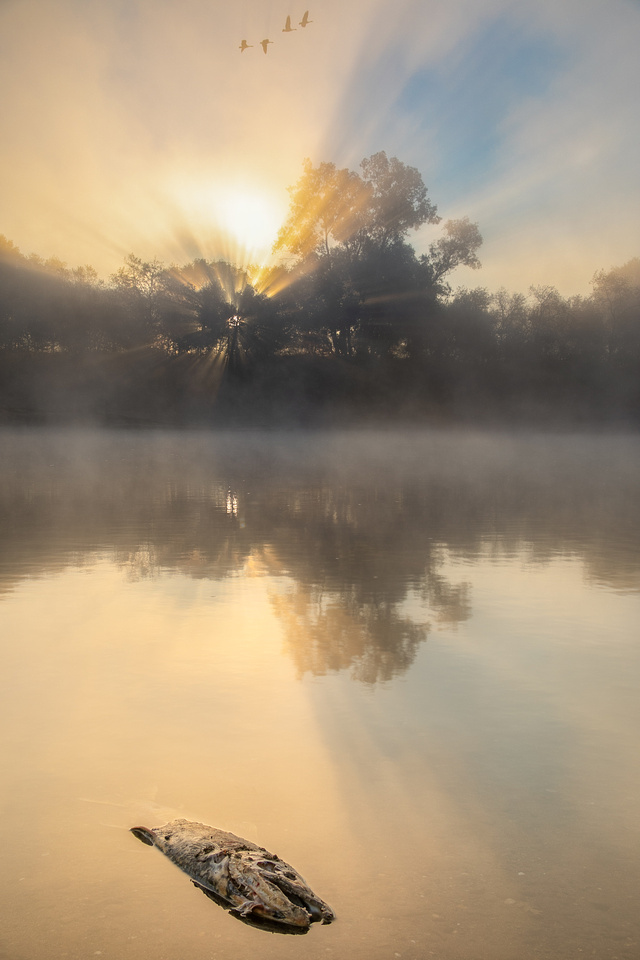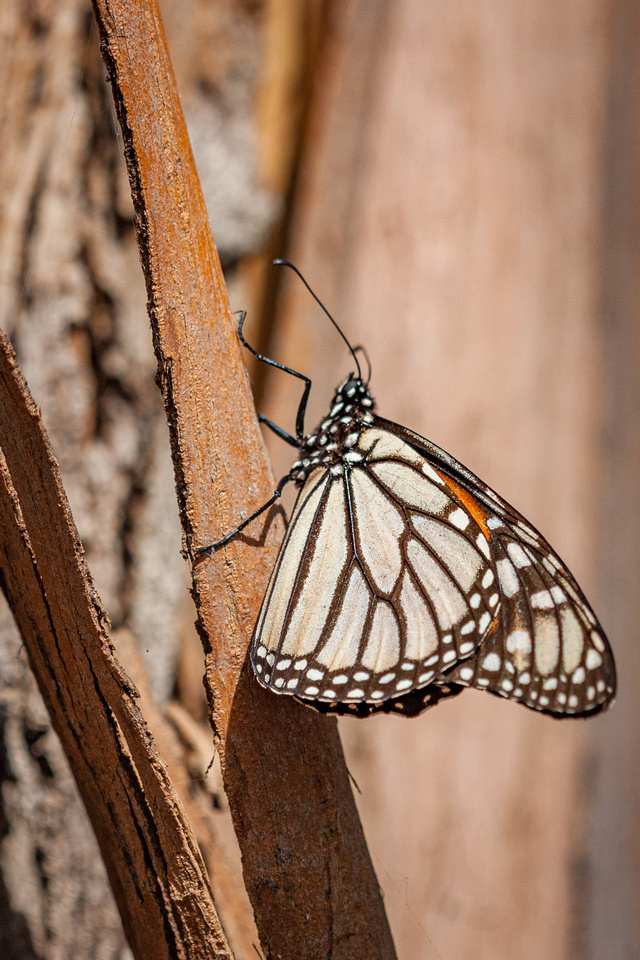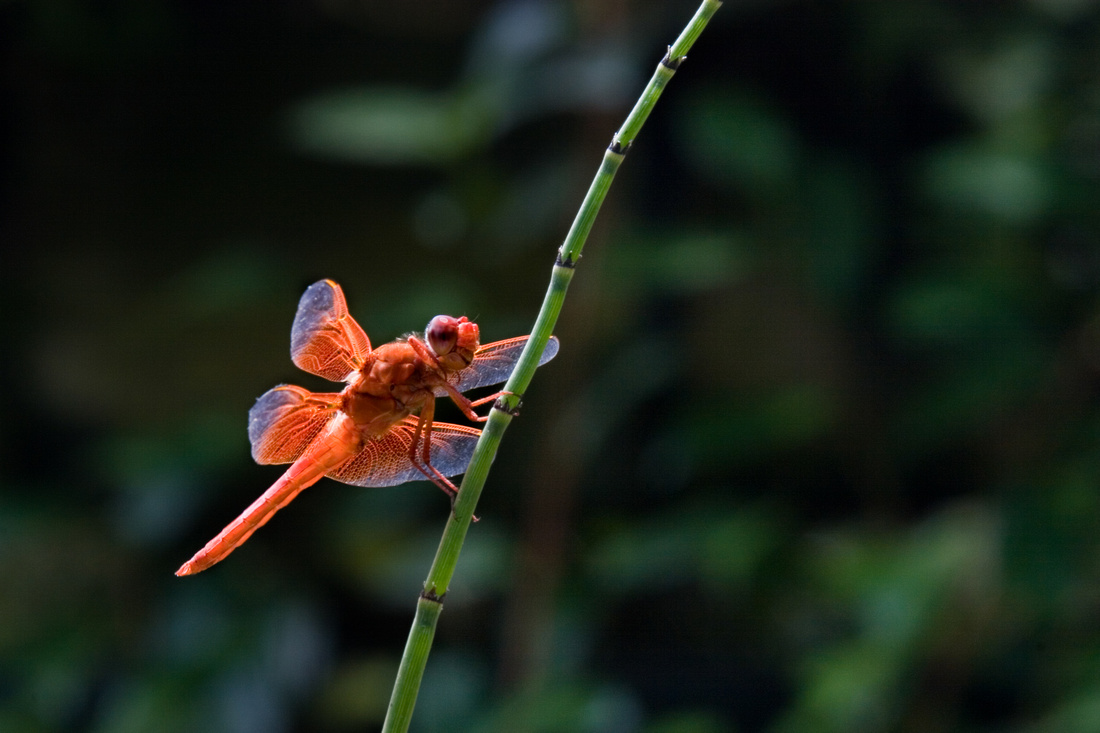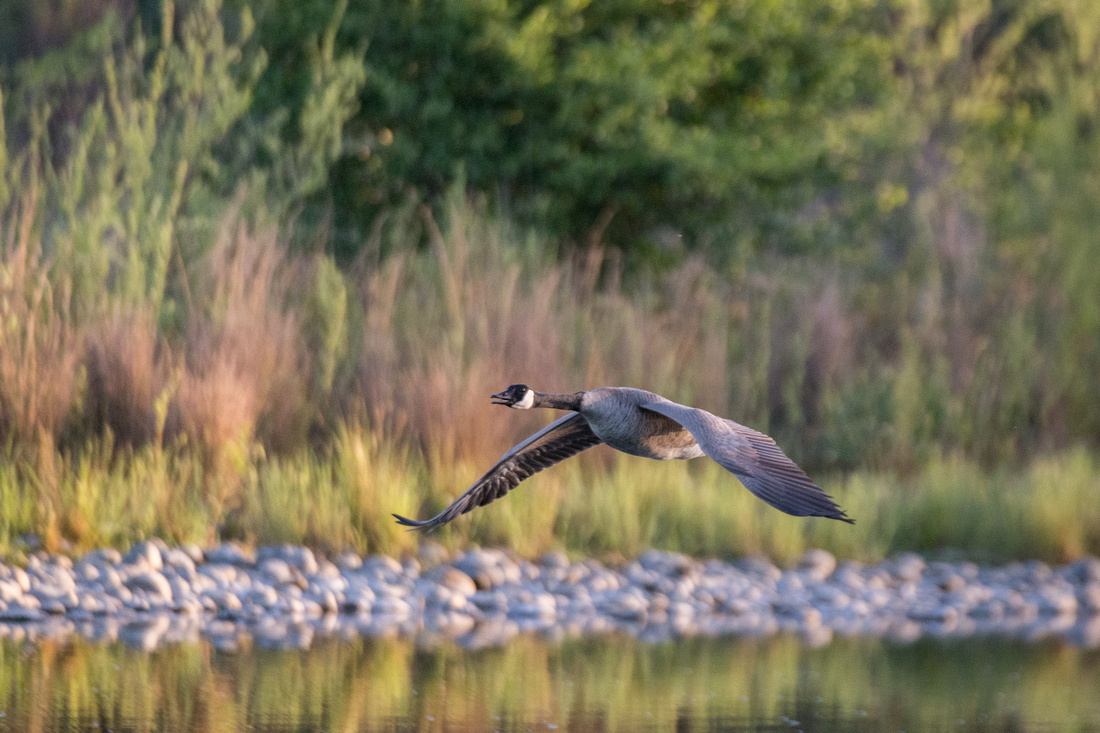Migrations
Migrations: Natures most fascinating story
Text and photos by Heather Cline
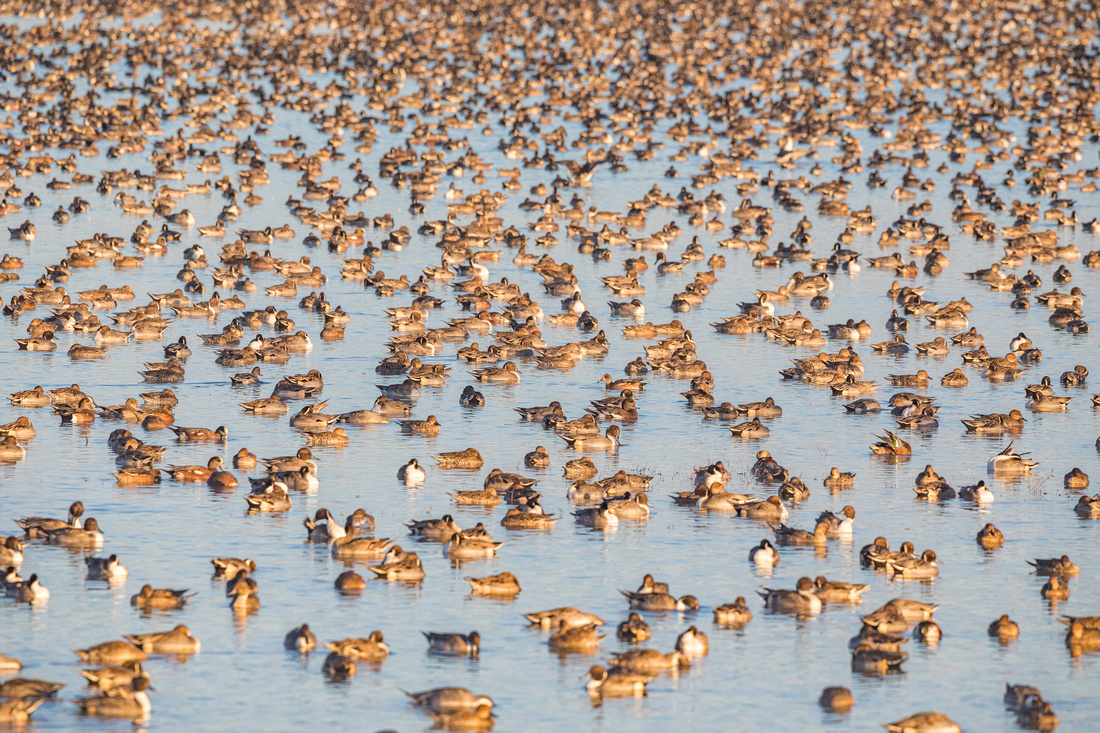 
Waterfowl overwintering at the Sacramento National Wildlife Refuge |
Autumn is the high season for wildlife migrations. While watching the Chinook Salmon completing their annual migration to their spawning site recently, this inspired me to create a post on the subject.
Wildlife migration is the long-distance movement of individual animals, usually on a seasonal basis. Migrations occur in all major animal groups, including birds, mammals, fish, reptiles, amphibians, insects, and crustaceans. Migration is different from general wandering and is defined by three characteristics: movement of a greater distance than the animal normally travels within its home range, movement that is purposeful and directional, and movement that has a defined beginning and end.
This article covers nine different species and their migration stories.
1. Salmon
The salmon migration, or run, is an annual event where salmon that were hatched in fresh water but spend most of their adult life in the ocean, swim back upstream to spawn in the creeks where they were born. After spawning, most species of salmon die with the life cycle starting all over again. In Northwest America, salmon are keystone species, in which other species in the ecosystem largely depend. If salmon where no longer present, it would have a significant impact on the ecosystem. Salmon that have spawned and died continue to contribute to their surrounding environment because of the nutrients present in their in their carcasses that are rich in nitrogen, sulfur, carbon and phosphorus, released back into the aquatic ecosystems. This benefits the wildlife that live in wetlands and riparian woodlands, including bears, deer, raccoons, coyotes, and many species of birds who feed on invertebrates living in the water.
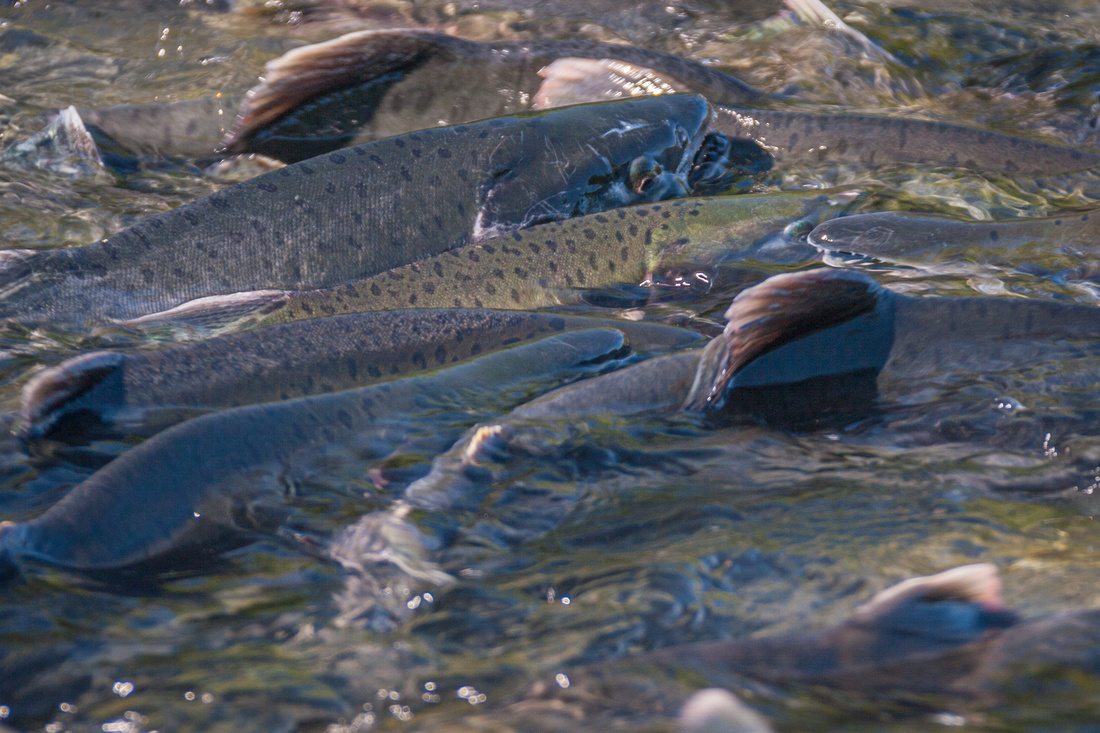 Pink Salmon Spawning, Alaska Click to open gallery Pink Salmon Spawning, Alaska Click to open gallery
|
|
A salmon’s ability to find their way home begins as soon as it is hatched, when they begin storing information about the creek's scents and geomagnetic (earths magnetic field) characteristics. The fish are triggered to start their long journey back home through a combination of genetic impulse, day length, and maturity. The age of maturity varies between species, ranging from 2-7 years. Salmon travel hundreds of miles, eating little to nothing along the way, fighting their way up the current back home, so they can continue moving their species forward. Their bodies go through a drastic transformation during this time, changing color and formation. Scientists compare this to aging 40 years in a matter of weeks. Once at the spawning grounds, the female salmon hovers close above a bed of gravel while facing the current. She rolls onto her side so that her tail is flat against the gravel and with the force of her body, shovels out a depression in the gravel to deposit her eggs. When it is deep enough, she releases her eggs into the nest, as the male accompanying her releases his sperm. Nearly all the eggs are fertilized during this process. Once she is done, she will swim upstream and begin the process all over again. As she digs a new depression, the uplifted gravel will cover the previous nest, protecting her previously laid eggs. Once the female has completed this process numerous times, she remains near the nests to defend them from being dug up by another salmon until she dies.
|
|
Most salmon species migrate between September and November. There are seven species of salmon which five of those occurring in the Pacific North America and the remaining two in Asia. Those found in the United States are found in tributaries of the Pacific and Atlantic Oceans. The most significant threats to the survival of salmon today include disease spread from fishing farms, climate change, and infrastructure (such as dams) that impede streams and watersheds.  Kokanee Salmon spawn, Taylor Creek, Lake TahoeClick to open gallery Kokanee Salmon spawn, Taylor Creek, Lake TahoeClick to open gallery
|
| Want to know how you can help protect this magnificent species? Conserve fuel, electricity, and water - clean air, water in our streams, and less need for dams all benefit salmon. Avoid using pesticides and stick to biodegradable products, Whatever you flush down the drain makes it into their habitat. Get involved and share what you know with others! |
2. Monarch Butterfly
|
Monarch butterflies make an annual migration that is truly unique and amazing as it is the only butterfly species to migrate north and south just as birds do. Monarchs are also unique in that they cannot survive the cold temperatures in the northern climates. Environmental conditions, such as temperature, trigger the migration south. There are two populations of monarchs: the Eastern North American Population that overwinter in Mexico and the Western North American Population Monarchs that overwinter in California along the Pacific coast near Santa Cruz and San Diego. Monarchs use a combination of air currents and thermals to travel long distances. Some fly as far as 3,000 miles to reach their winter home! Researchers are still investigating what directional aids monarchs use to find their overwintering location. It appears to be a combination of directional aids such as the magnetic pull of the earth and the position of the sun among others, not one in particular.
|
|
Monarchs only travel during the day and need to find a roost at night. Monarchs cluster together during the cool autumn evenings to stay warm. Tens of thousands of monarchs can cluster on a single tree. Roost sites are important to the monarch migration. Many of these locations are used year after year. Often pine, fir and cedar trees are chosen for roosting. These trees have thick canopies that moderate the temperature and humidity at the roost site. In the mornings, monarchs bask in the sunlight to warm themselves. While traveling south, Monarchs congregate on peninsulas. They congregate along the shore to wait for a gentle breeze to help them cross the shortest distance across open water. The northern migration is tracked by an organization called Journey North. You can help track this organization track the migration by reporting your sightings! |
3. Sandhill Cranes
Three subpopulations of sandhill cranes are migratory: the lesser, greater, and Canadian sandhill cranes. Migratory sandhill cranes have a fall and spring migration period. They winter in Texas, California, Arizona, New Mexico, and Mexico and begin the migration to their breeding grounds each spring. the month the birds begin their seasonal travels depends on what region they are coming from. Generally, sandhills migrate south between September and November. Then return north between February and April. In Early Spring, sandhill cranes migrate north and can be seen in a variety of states in the West and Midwest, but nearly 80% of all cranes congregate along an 80-mile stretch of the central Platte River in Nebraska, to fatten up on waste grain in the empty cornfields in preparation for the journey to their Arctic and subarctic nesting grounds. During this time, they gain 20 percent of their body weight.
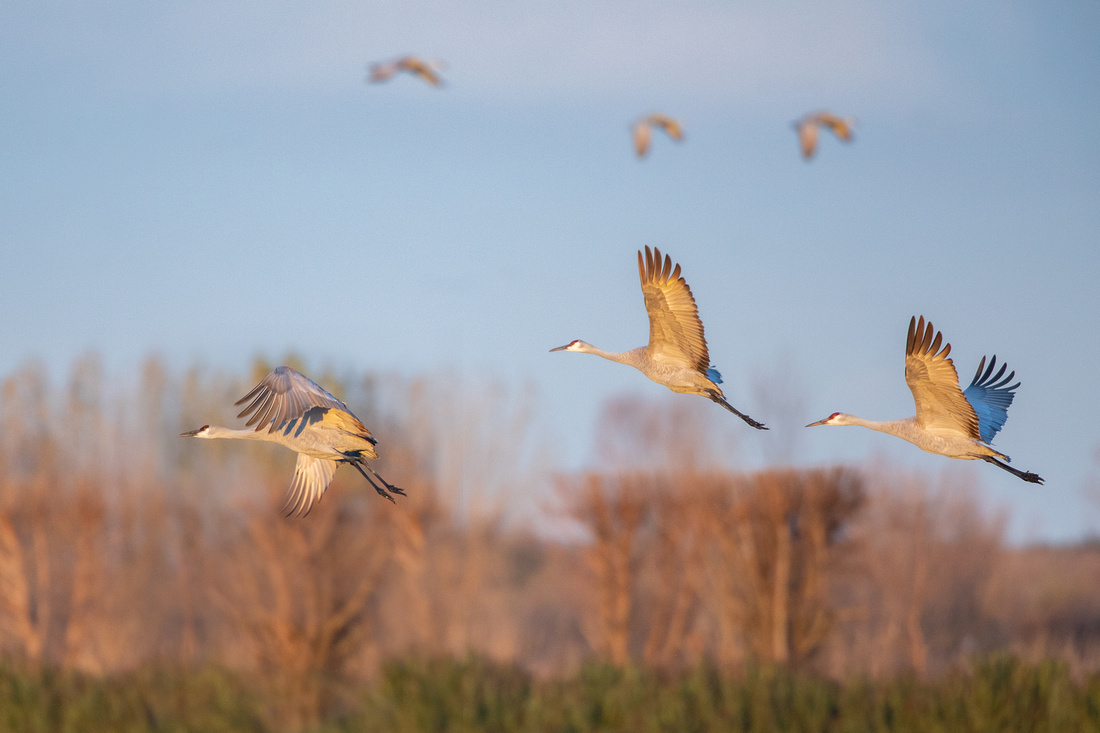 Sandhill CranesClick to open gallery Sandhill CranesClick to open gallery
|
|
Sandhill cranes complete this migration cycle to escape the harsh winters that occur in their native breeding grounds of Siberia, Alaska, Canada, and the northern continental US Many sandhill cranes migrate extraordinarily long distances. How far sandhill cranes migrate depends on where they are flying from. They may cover nearly 300 miles in a single day but could reach as far as 500 miles with good tailwinds. In total, some travel over 5,000 miles from their summer nesting habitat to their wintering grounds. Sandhill cranes often migrate within smaller family groups. However, they will gather in extremely large flocks at stopover sites along the migration corridors. The cranes use these key staging locations to recuperate, hunt, and socialize before continuing their long journey south.
|
|
Sandhill cranes generally only migrate during the day when they have good tailwinds. However, if the birds are only 100 or so miles from their destination, they will sometimes continue late into the night. After sandhill cranes have undergone their long migration south, the birds flock to prairie and marsh habitats to hunt and socialize throughout the winter months before beginning their spring migrations back to summer nesting grounds. |
4. Wildebeest
|
Each year, over two million wildebeest migrate through the Serengeti and Masai Mara in search of green pastures. While the numbers are smaller, they are accompanied by Zebra and Gazelles numbering in the hundreds of thousands, and is known as the greatest wildlife event on Earth. It is certainly the largest migration on Earth. The biggest challenge the migrating herds face are the predators, such as lions, cheetahs and crocodiles that follow the large herds in search of food. Their greatest weapon is their massive numbers. Despite that, 250,000 wildebeest and 30,000 zebra are killed during the migration route. While successful predators leave some of the carcasses behind, the scavengers benefit from this, thus contributing to the balance of the food chain and ecosystem.
|
|
The wildebeest migrate over 300 miles around the Serengeti, and into the Masai Mara for the sole purpose of following the rainfall. It is unclear how the wildebeest know which way to go, but it is generally believed that they follow the rains and the growth of new grass. Wildebeest typically inhabit the Serengeti plains of southeastern Africa. They graze in the savannas and open woodlands of the plains, between Tanzania and Kenya. After calving in the southern part of Tanzania's Serengeti near the Ngorongoro Conservation Area, the animals journey through the Serengeti up and around in a clockwise direction towards the Masai Mara in Kenya, before returning once again near the end of the year.
|
From July through October, wildebeest are generally in the northern Serengeti plains. This is where thousands cross the Mara River, marking one of the most spectacular events during the migration route. From December through March the wildebeest are in the southern area of the Serengeti, in the Ngorongoro Conservation Area, which is also marked as calving season.
 Wildebeest motion, TanzaniaClick to open gallery Wildebeest motion, TanzaniaClick to open gallery 
|
5. Dragonflies
|
Dragonflies migrate across every continent except Antarctica, with at least 16 migrant species in North America. The best-known of these is the common green darner, which is exceptionally large measuring about 3 inches in length and wingspan. These dragonflies occupy the Eastern United States and studies have been conducted on their migration routes and behaviors. Along the West Coast, the arid climate means migration is more sparse as well as the knowledge of their migratory patterns. Here is what we do know: those dragonflies that migrate from the north-eastern coast of the United States are not the same individuals that return the following spring. The round-trip flight can take 3-4 generations to complete.
|
|
Researchers believe dragonfly migration may be influenced by environmental triggers, such as temperature and daylight. Dragonflies are able to hover, dive, fly backwards or upside down, and reach speeds of up to 30 miles per hour. Each of their four wings acts independently, meaning a dragonfly can be missing one wing and still carry on.
|
6. Elephant Seals
|
The northern elephant seal has one of the longest migrations of any mammal with some documented as traveling over 13,000 miles roundtrip. They migrate in search of food, spending months at sea and often diving deep to forage. Males and females migrate to different places and eat different foods. Males tend to head north to towards the Gulf of Alaska and forage for food along the bottom, while females feed further south between the 40-45° latitude. This difference may be attributed to males needing more and higher calorie food sources.
|
Elephant seals travel into the North Pacific twice a year, in a pattern called a double migration. They go to forage and build up energy reserves that allow land-based activities while fasting for 2-4 months. Over the course of these two migrations, males travel about 13,000 miles, spending 250 days at sea. Females travel slightly less at 11,000 miles, spending 300 days at sea! The seals come back to land twice a year, once to give birth and mate, and another time to molt.
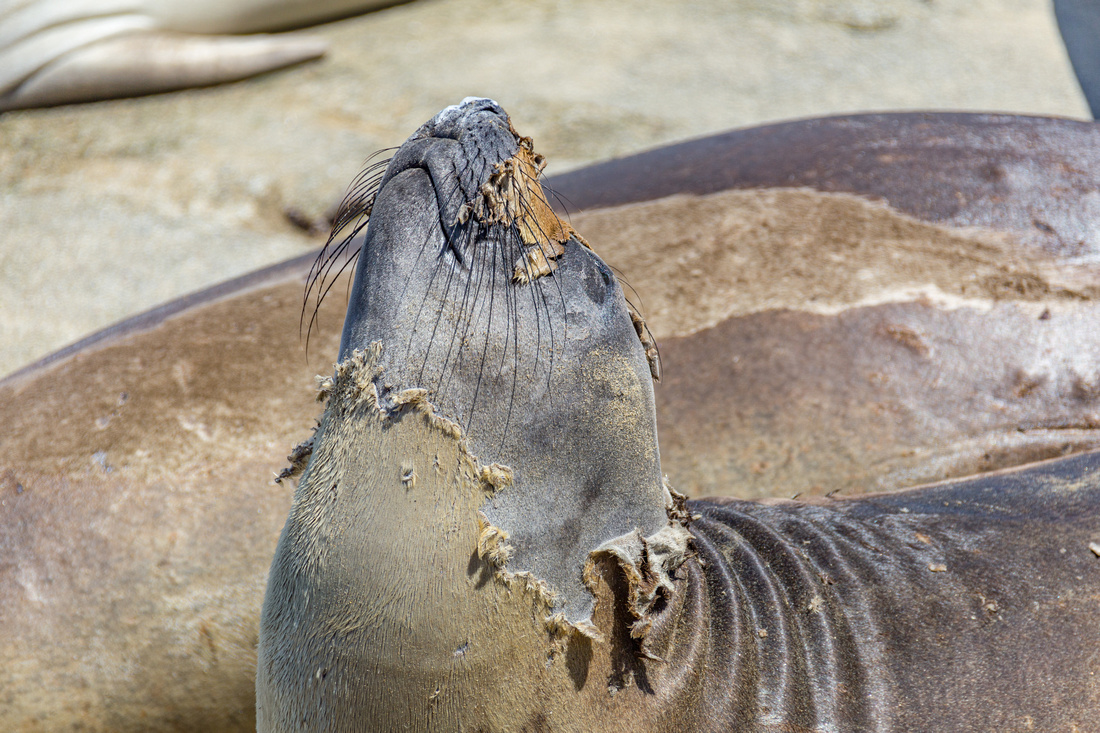 Elephant Seal moltingClick to open gallery Elephant Seal moltingClick to open gallery
|
|
A typical migration calendar looks like this:
|
7. Canada Goose
|
The Canada Goose migration takes place twice a year, heading south in September or October and back north from April to June. The southern migration is influenced by their instincts, and the northern is due to the weather. Canada Geese migrate for two reasons:
|
|
With an average life span of 24 years, Canada Geese may make two dozen migrations in a lifetime. However, not all Canadian Geese migrate. Those who migrate generally originated in the colder Canadian climate. With each migration, Canadian Geese return to the same place where they were born each year, and use the same "rest stops" along the way. You can easily spot this migration during the months of April and September as Canadian Geese fly in an identical V formation flock.
|
8. Snow Goose
|
The Snow Goose is an abundant migratory water bird that completes two migrations each year, one north and one south, much like other birds and wildlife species. The northern migration begins in the southern United States as early as February, arriving at their breeding grounds by the end of May. The tundra of the far north provides rich foraging grounds and a relatively safe place for these birds to raise their family of 2 to 6 goslings. They time their arrival in their northern territories to coincide with the melting snow and thawing ice. Their summers are short lived however. Once breeding is complete, the birds molt and then begin a long migration south. Their return migration in the fall begins in September and is usually completed by December. They escape the extreme northern winter by making their way south along major flyways to spend the winter in the relatively mild climate of the Lower 48 states.
|
|
Snow Geese do not complete their migration without stopping. In fact, these birds make long stopovers at regularly used staging grounds. The largest migration predator threats they face are coyotes and eagles. A typical migration calendar looks like this:
 Snow GeeseClick to open gallery Snow GeeseClick to open gallery
|
9. Polar Bears
|
Like any other species of wildlife, Polar Bears are guided by their instincts to find a safer location even if it means traveling hundreds of miles to ensure their survival in an event that is known as migration. The Polar Bear migration is different from the other migration covered here because they migrate towards the ice packs that enable seal hunting, which is critical to their survival. When the ice in the Arctic Ocean starts to melt, this triggers the polar bears to start their migration towards reforming ice packs with plenty of available food. Some polar bears have also been documented to migrate onshore, which is the case for the bears found in Hudson Bay, Canada. These bears are also considered to be the most observed and studied group of polar bears. Polar bears have been observed following a North to South migration pattern and have been seen on the ice packs found all over the Arctic Ocean. Once the ice starts to reform during Autumn, which usually starts in September, bears start their migration towards the ice packs again. Due to the intensifying climate change, the ice packs around the arctic sea are starting to melt at a terrifying rate and reforms later than usual. These factors have caused a disturbance in the migration process of the polar bears and are increasing their mortality rate as well.
|
Animal migration involves travelling from one location or habitat to another, and is often linked to the changing seasons. The migratory journey poses extreme energetic demands on the animal, and is often fraught with hazards and hungry predators. Migrating wildlife use a variety of cues to trigger each migration and to find their way and many travel hundreds of miles to complete the journey. We are truly fortunate to be able to witness these amazing spectacles and I hope this article has inspired you to observe some of our migrating species this season - and in the next!
